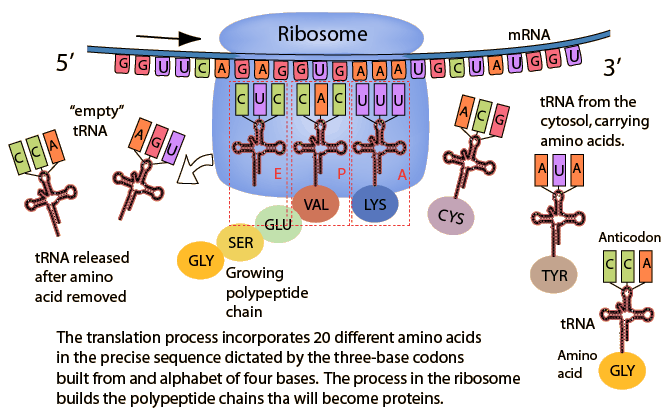

Biology is Too Hard
And the Mark Schemes are never clear
Genetic Control of Proteins
There are 3 different types of RNA that you need to know - mRNA, tRNA and rRNA. However for this exam you will only be expected to know the basic structure for mRNA and tRNA.
mRNA=messenger RNA
tRNA=transfer RNA
rRNA=ribosomal RNA.
The basic units that make up RNA are the same across all three molecules. RNA is a POLYMER made up of repeating units, which form a single stranded molecule.

The structure of a single strand of RNA is similar to that for a single strand of DNA. However there are a few key differences.
1) One of the organic bases (Thymine) is replaced by another base called Uracil.
2) The sugar is not de-oxyribose but just ribose.
3) RNA is always single stranded and not double stranded.

The structures of both mRNA and tRNA are shown to the right. Remember mRNA is single stranded and tRNA has a distinctive clover leaf shape.
Also remember from AS Biology that:
1) A sequence of three bases on a length of mRNA is known as a codon, and every codon codes for a single amino acid.
2) There are 20 amino acids.
3) Some of these amino acids are only coded for by one codon.
4) Most amino acids are coded for by more than one codon. For instance Valine has 4 different codons. This is known as the degenerate code.
5) Three codons do not code for any amino acids - instead they code for a stop in the polypeptide chain.

TRANSCRIPTION
This is the process of making pre-mRNA from a DNA template - i.e. a gene sequence in the DNA molecule.
1) DNA Helicase breaks open the DNA molecule to break the Hydrogen bonds.
2) A second enzyme called RNA polymerase moves along one of the two DNA strands, called the template strand or the anti-sense strand. It joins RNA nucleotides together, which are complementary to the bases on the DNA strand.
3) Remember, wherever there is an Adenine base on the DNA strand a uracil base will appear as the complementary base on the newly forming pre-mRNA strand.
4) As the pre-mRNA strand is being built the DNA strands re-form behind it. When the RNA polymerase recognises 3 DNA bases as a STOP triplet code, it detaches and the pre-mRNA is complete.

Splicing of pre-mRNA
Once the mRNA transcript is made it then undergoes splicing. The immediate copy of mRNA is known as pre-mRNA.

When the pre-mRNA is generated it contains introns and exons. Introns are the sections in green shown above. These are spliced out of the pre-mRNA transcript to make a mature mRNA transcript. What is left are the different exons. These code for a certain polypeptide. The above diagram shows that alternative splicing can also happen. This is where the exons can be arranged in a different order to code for a different polypeptide.

Sometimes pre-mRNA is called nuclear RNA - but you probably wont see this term - the exam board uses pre-mRNA.
Translation
When the mature mRNA transcript moves out of the nucleus - through the nuclear pores - it travels to a ribosome.(Site of protein synthesis.) A ribosome is in effect a giant mix of protein and rRNA (ribosomal RNA). It is in the ribosome that the mRNA will interact with tRNA to produce a polypeptide chain.

Remember - after this the completed polypeptide chain will move throught the rough ER and then into a vesicle. The vesicle containing the polypeptide chain will move through the cytoplasm to the Golgi body where it will have bits added to it. Things like sugar groups - making it a glycoprotein for example. Or it might be joined with other polypeptide chains. Both of these events will give the final protein a quaternary structure. Above A - level this is referred to as post - translational modification.
In the diagram opposite, the mRNA is being read from left to right as you are looking at it. GLY, SER and GLU have already been added. The next amino acid to be added is VAL. As you can see this is being coded for by the three base codon GUG on the mRNA. The anticodon to this is CAC on the tRNA molecule. The amino acid after that is LYS and this is coded for by the three base codon AAA. The anticodon to which is UUU. So it is clear to see that 1 tRNA molecule has a site where an amino acid can bind at one end of the molecule, whilst at the other end of the molecule there are three bases called anti-codons. The anti-codons form hydrogen bonds with their complementary bases (codons) on the mRNA molecule. As they do this the amino acids are brought in close proximity of eah other and a peptide bond is formed.